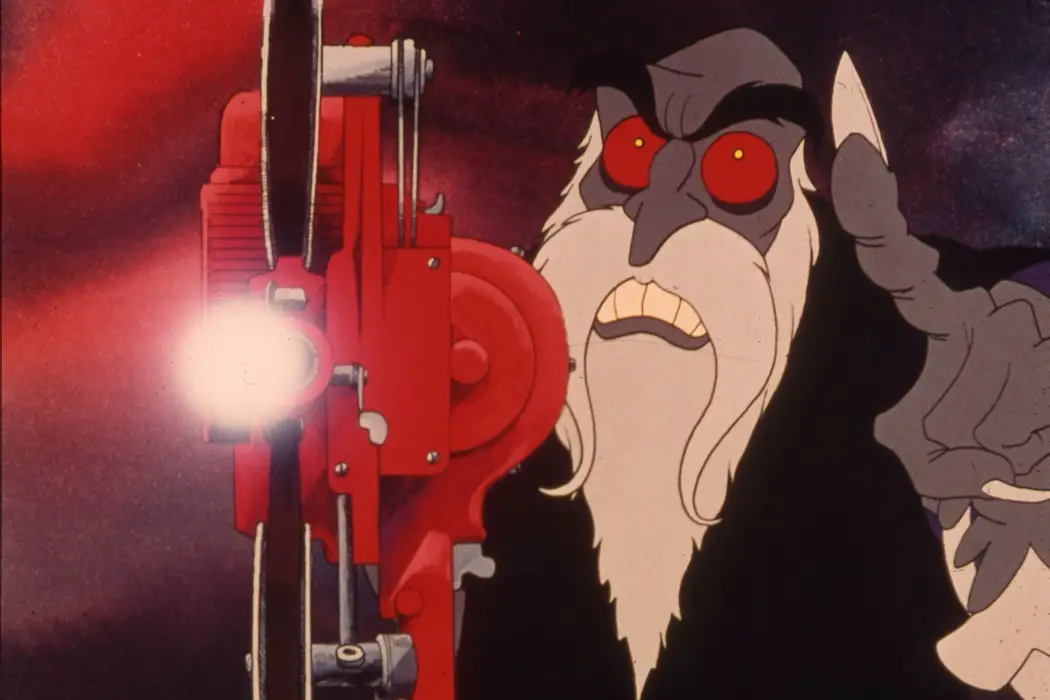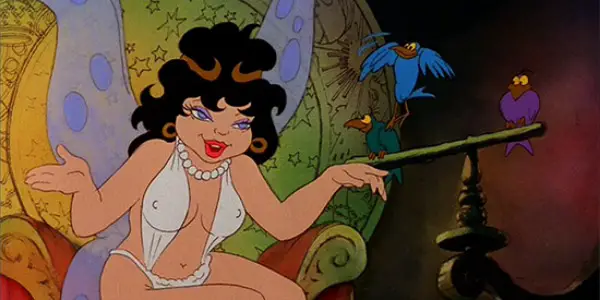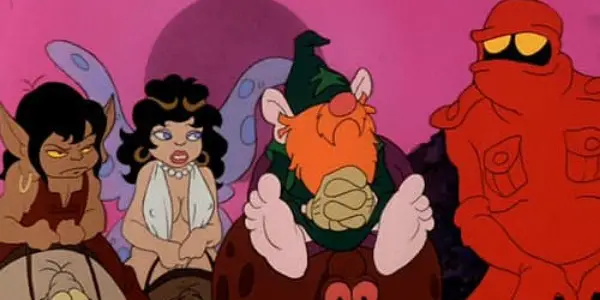Animation Sensation: WIZARDS, Ralph Bakshi’s Bonkers Foray Into Fantasy

If there is one word that can sum up Dallas…
Film Inquiry introduces to you Animation Sensation! Twice a month, I will be presenting some of the most intriguing, fascinating, and fun films that the art of animation has to offer. Join me as we explore worlds that only animation can bring, but a word of warning is in order: there will be spoilers.
Post-apocalyptic setting? Magic battles? Nazi imagery? Oh, we are in for a bumpy ride! Not just any bumpy ride, but a Ralph Bakshi romp into terrain that few dare to tread. And this movie is one that was intended for a younger audience! Only a man like Bakshi could be so foolhardy to craft a crazy fantasy film such as Wizards.
Ralph Bakshi is no stranger to risk and making daring moves in the world of animation. He was, after all, the first animator to produce a cartoon that was not only given an X rating for — but also became a box-office hit. His earliest films were centered around urban life, where gritty realism collided with goofy animation to make something twisted but poignant in its own messy way. Heavy Traffic and Fritz the Cat were urban dramas that touched on poverty, drug addiction, domestic violence, and racism.

Both films were not only a financial success at the time but have gone down in animation history as daring explorations of social and political issues. Bakshi‘s 1977 film, Wizards, would go on to reach the same financial success. And while it was just as daring — being the first of his filmography that would have a fantasy setting — it is lacking. This is not an indictment of the film. In all honesty, I love this movie for its flaws and for what it lacks in comparison to its predecessors; it makes up for in vision.
But the rose-colored glasses must come off, pried from my eyes as a more objective view comes into focus. Wizards was too ambitious for its own good.
In the future, magic reigns supreme, and the Nazis come back!
The mess of a plot is as follows. Told through an over-exposition of dialogue at the beginning of the film, viewers learn the world is devastated by nuclear war in the future. After two million years of the world cleansing itself, the actual ancestors of man: elves, dwarves, and fairies rise from the ashes to build a new world. And here we thought that Charles Darwin‘s theory of evolution explained the origins of man — no, you fool, it was magic creatures all along!
But not all is sunshine, lollipops, and fairies. On the other side of the world live the mutants relegated to the badlands of disease and radiation. But back in the good lands of the woodland creatures of magic lives the queen of the fairies, who one night is put under a spell and gives birth to twins. But these twins are not just mere children but powerful wizards. One, a child of life who is all smiles and brightness named Avatar, and an evil son named Blackwolf.

As is typical with the whole good-twin-evil-twin stories, Blackwolf tries to take over and is defeated by his brother — who banishes Blackwolf to the badlands. Blackwolf then swears he will raise an army and make the world one where mutants reign supreme. How does Blackwolf do this? Using lost technology such as guns, tanks, and raising armies from hell — just another day at the office. Oh, finding old Nazi propaganda and ushering in the fourth Reich is also on his to-do list of villainy. It’s old-world magic versus technology. Who will come out on top!
This is supposed to be for kids?
Ralph Bakshi, known for raunchy animated features filled with sex, violence, and drugs with gritty urban backdrops — wanted to branch out. Wizards was his first foray into fantasy, and it is one of the trippiest, hit-the-ground-running experiences in animated history. And while toned down compared to his previous work, Wizards is far from pleasant family viewing. While there is no sex, innuendo still rears its head on several occasions — especially regarding the sexpot female lead of Elenor, who is half-naked throughout the film and speaks almost every line like a horny schoolgirl.
There is no doubt in my mind that some guy had his first sexual fantasy when seeing this in theaters as a kid with his unsuspecting parents back in the day. Congratulations, Elenor, you have reached (albeit intentionally as far as Bakshi is concerned) the hall of the horny boy, cartoon crush, fame — alongside Jessica Rabbit and Lola Bunny.
As Ralph Bakshi states in interviews about his work on Wizards being a “kids film,” it is hard to reconcile that. There is also blood aside from half-naked fairy girls, innuendo, and the villains sporting Nazi imagery. It is not just a little here or there, but bloody in the sense that blood spurts out like ketchup that has pressurized itself towards the top of the bottle during war scenes. It’s intense enough that a movie aimed towards a family audience has many war scenes, to begin with, but couple that with the sordid consequences of said war and Wizards having a PG rating is a joke.

Then again, 1977 PG is a horse-of-a-different color compared to the fluff that posits a Parental Guidance rating today. The PG rating in the 70s and 80s wasn’t messing around! If Wizards were released today, the PG-13 bandwagon would be rolling down the MPAA road in full swing.
Wizards is an ugly yet fascinating film to look at…
If I was to describe just about any Ralph Bakshi production in a phrase, it would grotesque-yet-fascinating. Watching the films that he created before Wizards is a test for the eyes. Characters look like the doodles that a teen of an inner-city high school would draw beneath the school desk, complete with all of the violence and boob drawings. Bakshi‘s designs are very much the stream of consciousness of a man who has seen a lot of tough times throughout his life. The characters look like something Max Fleischer would design, but doing things that would be taboo, to say the least.
Bakshi also has a habit of melding the real with the animated via rotoscoping, which gives the entire production an unease or sometimes uncanny valley feel. His earlier films, Fritz the Cat and Heavy Traffic, are the forerunners, but Wizards is where Bakshi utilizes his avant-garde style to the max. Trippy is the best description, and considering that the man reached mainstream popularity in the early seventies, no surprise that a lot of his animation looks like the ubiquitous acid trips of the era. These are where the ugly parts are, but what about the fascinating?
While character designs are not the best to look at, some backdrops of Wizards really do add to the ambiance of the film. The land that Blackwolf rules over, Scorch, is like a semi-cubist charcoal painting that gives a feeling that the place is an industrial hell hole. The attention to detail is staggering the longer one looks upon it. Contrasted by Montagar, the stomping ground of the elves and fairies looks like a place where a hobbit would reside with sloping hills, fairy tale cottages, and deep forests.
Montagar feels homey with warm light and rounded buildings, where Scorch feels dangerous with jagged edges and various blacks and grays. The setting is half of the visual prowess of storytelling, and as far as graphics go, Wizards excels at building a world.
A special shout-out must be given to another artist who worked on Wizards named Mike Ploog. Ploog was a former Marvel Comics artist who also worked on the concept art for Wizards, whose paintings were utilized in any scene where the narrator gave an exposition of past events. His artwork is beautiful, with a muddied and brown tone monochrome effect that provides the film with oomph compared to Bakshi‘s sloppy look.
However, none of these are sleights against Bakshi since his work has a silly charm, and Wizards wouldn’t be the same without it. But Ploog‘s work feels more of what an epic fantasy film should look like and just goes to show how out-of-element Bakshi really is. To be fair, this was the first time that he was moving from gritty stories about life in the inner-city to a fantasy film, and Bakshi did smooth out his rougher edges with later fantasy films.
Storytelling is not Bakshi’s strongest trait…
An extrapolation is in order so to make things clear, coherent and linear storytelling is not Ralph Bakshi‘s strongest trait, specifically. Examining his earlier films of Fritz the Cat, Heavy Traffic, and Coonskin were less dependent on linear storytelling and were closer to vignette pieces. Characters in those films would find themselves in situations and said situations would wrap themselves up, only to then rinse and repeat the process. Coonskin, for example, might have had a loose story but nothing that required a strenuous making of the plot ends meet.

A day in the life of crooks and inner-city con-men is chaotic and slapdash as it is, and Bakshi‘s fractured storytelling style captures this dysfunction well. But a science fantasy epic (or at least that’s what Wizards was intended to be) like Wizards is entirely dependent on the story being as coherent as possible. And when it comes to the plot, Bakshi is out of his comfort zone.
Bakshi will introduce characters and then kill them off within minutes of their arrival. Such story elements are not a problem in and of themselves. With Wizards, it almost seems comical at points with character deaths. It all seems rushed and feels like random acts of violence instead of violence being a catalyst for the plot. Think of something like Bruce Wayne’s parents being murdered in Batman.
Such a death was meaningful, for it molded Bruce into becoming the hero he needed to be. Contrast that with Elenor’s father, for example. There is a scene where Elenor’s father — one of the leaders of the good lands of fairies and elves — is killed by the assassin Necron-99. The cool-looking guy in red that is on the movie poster for Wizards, Elenor’s father is destroyed so quickly, and then Elenor’s emotional response is so rapid and thrown in the viewer’s faces that the whole event feels cheapened and almost farcical.
Did such a death amount to anything? Was it important? No, of course not. Bakshi has to move on to the next exhibition. At this point, Wizards does not even feel like a story but a mere tour through a fantasy land upon which Bakshi throws something in your face and gives little explanation, and then moves right along. The viewers are there for the ride, and no matter how much the members on the tour bus may raise their hands and ask with a perturbed expression on their face as to what the hell just happened — our crazy tour guide rips and roars onto the next thing.
Speaking of things being rushed, the ending of Wizards is the epitome of an anti-climax. The movie poster of Wizards promises the viewer an “epic fantasy of peace and magic,” but the ending delivers neither. When the words magic and epic are thrown about, one would expect a marvelous duel of battling wizards, duking it out for supernatural supremacy with spells hurtling against each participant. Considering that the two wizards in this world are brothers, the battle should feel more personal, with the stakes and emotions running high.

Oh, you silly goose! Have you not learned anything? Bakshi runs through this like Tony Montana does through cocaine, and much like the protagonist of Scarface, Blackwolf dies by a gunshot. Just when the viewer was teased by a battle to the death by twin brothers who are master wizards, Avatar shoots his brother dead just when the light-side and the dark-side were coming together like a storm of good versus evil. What took about an hour and a half of build-up in storytelling was gone with a single bullet. Some may say that Blackwolf’s death was ironic, that while his brother shunned technology (for the most part), Blackwolf was killed by it due to his dependence on it. Such an argument would be valid if only it did not happen so fast. So many promises and build-up, only for a laughable letdown.
All in all…
For the seeming stones I have cast upon this goofy animated feature, it seems strange that I mentioned in the beginning that I love this film. It looks like I have more scorn for it than appreciation and criticism than I do praise. These are correct statements. But this is still a favorite of mine because it does what many animated films (or films in general) do not do nowadays: take risks.
Much of what many animated films that run in the mainstream do nowadays are play-it-safe. Look at just about any trailer for an upcoming animated feature, and one will be hard-pressed to find out much that differentiates one from the other. Most animation in the Western world is filled to the brim with shiny CGI graphics (the over-saturation of computer animation is also a pet peeve of mine in American animation), pop-cultural references, cookie-cutter moral themes, and an array of other nitpicks that are worthy of a whole discussion at a later time.
On the other hand, Wizards was an American feature released in 1977 that had more gumption and took more risks than most animated features on the market do today. Bakshi might have told the story like a stumbling drunk who stopped a group of kids to warn them about the dangers of Nazism and propaganda, but there’s a haphazard sincerity to it. Also, telling a “children’s story” about the horrors of war and the propaganda that leads to it is something that only a man like Ralph Bakshi would dare do. While most animators nowadays want to take the easy road, Bakshi took the bumpy road, and whatever happens, happens.
In the audio commentary of the film extras, Bakshi stated that he wanted to make Wizards for a younger audience because he felt there was a lot of misinformation about war, the holocaust, and propaganda being sold to kids. “I didn’t want to lie to them,” he stated a few times throughout the film commentary. Despite the dubious means Wizards went about telling the truth, Bakshi’s intentions were good in that regard. Rushed, flawed, sometimes grotesque, unnecessarily sexual, but always fun in its own way, Wizards is worth checking out just for its audaciousness alone.
What do you think? Is Wizards a clever allegory for the fight against Nazism and propaganda? Or is it just an excuse for the raunchy and ridiculous ramblings of a mad-man animator? Let us know in the comments below!
Does content like this matter to you?
Become a Member and support film journalism. Unlock access to all of Film Inquiry`s great articles. Join a community of like-minded readers who are passionate about cinema - get access to our private members Network, give back to independent filmmakers, and more.
If there is one word that can sum up Dallas Marshall, it would be weird. He is a strange fellow who is also a writer, anime nerd, and film buff who can also talk for hours about mythology and out-there literature. He has been sighted at local used bookstores perusing for horror books and manga. He has also written a book about Japanese animation called Anime Adrenaline! Which can be found on Amazon. You can also catch him on his own website at www.Dallasthewriter.com













